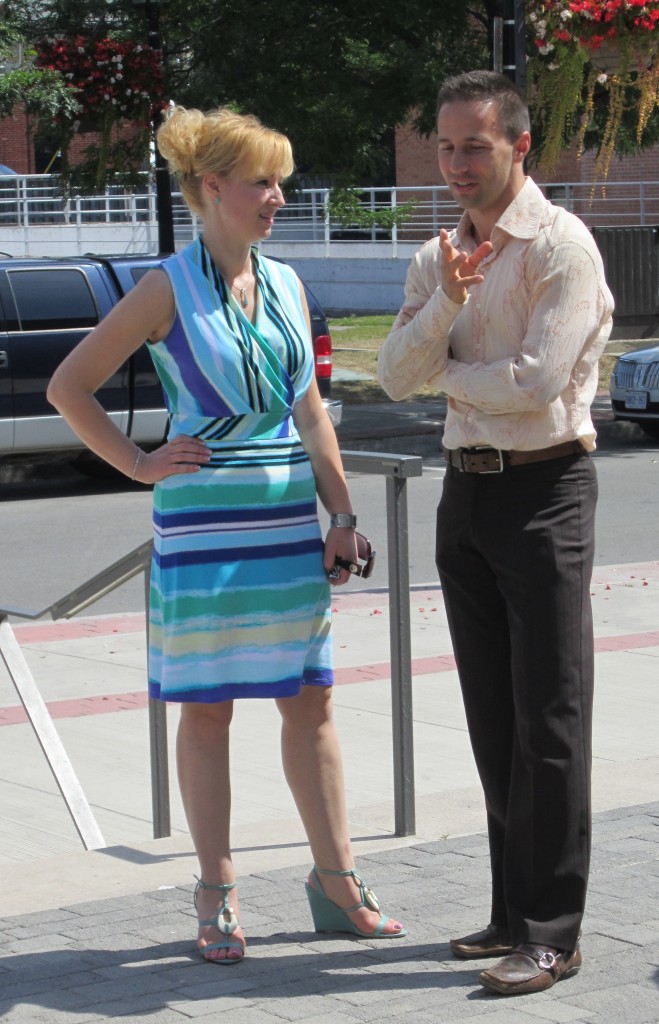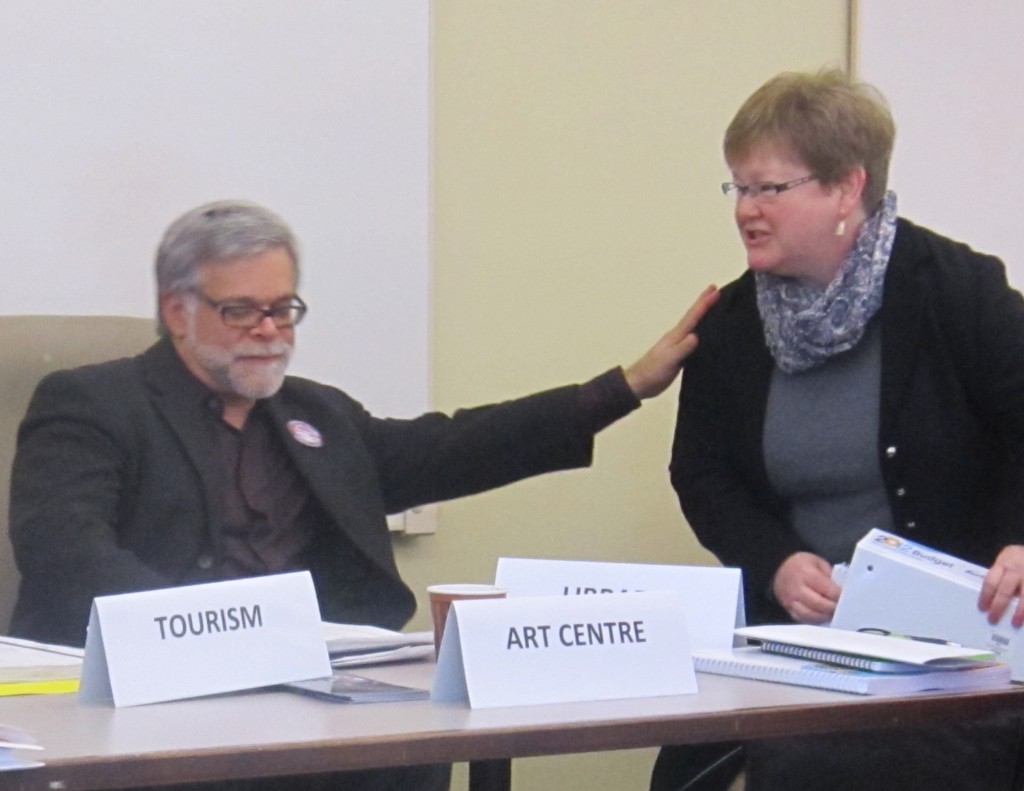March 5, 2014
BURLINGTON, ON
It looked as if all the Arts and Culture collective was going to get for 2014 was a cultural map – a place where those who felt they were part of culture and art in Burlington could register and say who they are and what they do.
The consensus around the horseshoe during debate at the Standing Committee was “perhaps next year”, which sort of left the cultural action plan in some kind of a limbo.
Someone, somewhere in city hall decided the arts and culture community had to be given something so they trotted out and launched a new, online cultural map to showcase Burlington’s many cultural assets.
Mayor Rick Goldring said the cultural mapping is “ a great platform to forge new relationships and strengthen existing ones among culture makers and consumers in the city.”

Jeremy Freiburger, on the right and Trevor Copp, second from the left, were two of the forces that got the city to the point where the city manager commits to giving the arts and culture community what they wanted by the middle of the year. The group is looking at Melanie Booth’s Olympic medal which became part of the Spiral Stella.
The map (perhaps not the best word to describe the service) is an online tool that shows the full range of cultural activity in the Burlington arts community. Residents and cultural groups can get information and discover resources including: cultural venues, creative cultural industries, creative professionals, cultural heritage and artists.
A very significant amount of money had been poured into culture starting with a strong document from consultant Jeremy Freiburger which had data the city had never seen before. In his Directions document Freiburger provided the kind of data that was needed to determine if there was a true cultural base in the city and some thoughts on the direction the city could take.
The city took the advice Freiburger provide and held a series of public meetings to craft a Cultural Action Plan (CAP) that the city approved. The next step was to implement that Action Plan – and that was the first stumble on the city side – at a Budget Standing Committee council decided not to fund a Cultural Manager – the person who would oversee the implementation of the CAP.
This was a significant setback for the arts and culture people who were now a very visible community. Up until the public meetings that worked up the CAP, no one really knew they existed. Trevor Copp who had been named Arts Person of the Year for 2011 was the visible part of the arts and culture community serving as the spokesperson much of the time.

The first the city saw of the arts community – that is the artists who do the performing and creating was when Trevor Copp appeared at a Standing Committee meting asking: Can I ply my trade in Burlington or do I have to schlep to Toronto all the time.
The Collective, as the arts and culture community became known, was not prepared to give up. When council decided to go from a Standing Committee into full council immediately after the budget recommendation on Tuesday, the short interval didn’t leave much time for the Collective to get its act together. They did have a Cultural Planner who had her ear to the ground and could advise them when to show up – and show up they did with two people delegating at the last-minute.
During those delegations mention was made that Freiburger, in his Directions report, had suggested the Cultural Manager not be put in place immediately which looked like the kiss of death for what the arts community felt was vital.
Then – out of the blue – and I mean, right out of the blue, city manager Jeff Fielding said he would do his very best to find room within the current staff compliment to find room for a Cultural Manager. He didn’t say if he was going to find the person for the job from within the existing staff compliment or if he felt a place would open up.
The city manager had previously advised council that he was going to do a total review of the work force and get a deeper look into what the city has in the way of talent, where there are weaknesses and how to develop what the city needs. There isn’t all that much in the way of bench strength – especially at the senior level. One would be hard pressed to name who the natural successor would be to either of the general managers.
Up until Fielding’s comment there wasn’t a hint that the Cultural Manager would be found and hired in 2014. It was certainly good news for the Collective. Most of the group that had attended Council held a hallway discussion with General Manager Kim Phillips who manages culture, which up until now has been part of the Parks and Recreation department.
Did Phillips even know what Fielding was thinking?

Angela Papariza was a recreational planner when this picture was taken. Her job was changed to that of a cultural planner and she is now the goto person on the cultural file – at least until a cultural Manager is hired. Is she a candidate for the Cultural Manager position? Papariza talks with Trevor Copp one of the movers and shakers within the arts and cultural community.
For the immediate future the arts community has a cultural planner they can work with and a cultural map they can populate.
The Workforce review should be done by the end of June – at that time the Collective will have a better sense as to what they are likely to get.
In the meantime the city manager has to review what he has in the way of a workforce and determine how it can be managed to deliver what the city needs. He has all kinds of tools under development to better measure performance: Service Based Budgeting; Results Based Accountability to name just two – will begin to come on-line as we work ourselves through 2014 and get ready for a significantly new way of doing business come 2015.
At that point the city will have a new council – don’t expect every one of the significant seven to be returned. There are some major surprises coming.
Expect some changes in the structure of the senior management team as well. Culture was a part of the Parks and Recreation department. Once the Cultural manager is in place expect a re-alignment with culture getting a place of its own on the city’s organizational chart. The intermediate and long term challenge is to make the cultural investment to date one that will result in a financially viable, robust business.
During the culture debates nothing was said of the potential for the cultural leaders in the city to form some kind of a committee to look at culture from that 30,000 foot level.

Ian Ross, chief cheese at the Art Centre offers a supporting hand to Maureen Barry, CEO of the library service during a Budget Bazaar in 2012.
Maureen Barry, the CEO of the Library provides a cultural base that is often overlooked. Barry is a solid strategic thinker with a reach into the community that exceeds that of anyone else. More people use the library than any other service in the city. Brian McCurdy, the head of the Performing Arts Centre and Ian Ross over at the Arts Centre have very significant experience with arts and culture. These three, collectively, are in a position to add some heft to the thinking that will get done to make Burlington a cultural force, both in the region and the province. But they have to meet and break bread first as it were.
When there is a Cultural Manager in place that person is going to work with the arts community of which McCurdy, Ross and Barry are the leaders.
There is much to be excited about – but a lot of hard-core work to be done.
Hope prevails.
Background links:
Standing committee took a pass on the cultural manager
Artists and cultural types want to be hard.



















